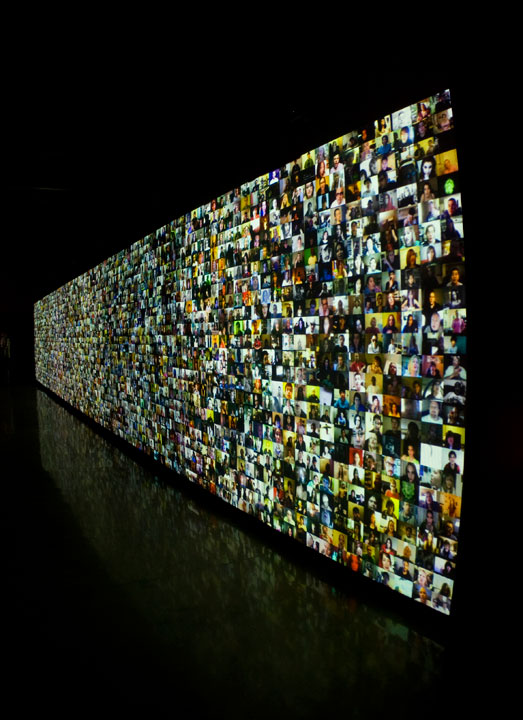Hello World! Or: How I Learned to Stop Listening and Love the Noise

Hello World! is a large-scale audio visual installation comprised of thousands of unique video diaries gathered from the internet. The project is a meditation on the contemporary plight of democratic, participative media and the fundamental human desire to be heard. [1]
“Hello World! Or: How I Learned to Stop Listening and Love the Noise” is a purposefully overwhelming work by Christopher Baker. Hello World is the first program that is traditionally taught in any programming language, and How I Learned to Stop Listening and Love the Noise references the Stanley Kubrick film Dr. Strangelove. The installation tries to capture the vast archive of one-person narratives that exist on the Internet and emphasize them as a collective whole rather than as individuals. This work “exemplifies the long and distinguished history of artistic attempts to democratize media by enabling users to participate as ‘content-providers,’ rather than as passive consumers of pre-fabricated entertainments and commercial messages.” [2] Contrary to the tradition the users made these videos without any intention of participation, which draws influence from a New Media category Digital Archivalism.


Baker encourages active participation by using projectors rather than a large video monitor. The viewer can then walk up to the wall and be drawn into the collage as the video is projected on to them. The voices of the narrators create a wall of sound projected from separate speakers. As the viewer changes locations the sound focuses in on different individuals but always returns to the symphony of monologues.
There are many examples of contemporary works that “Hello World!” is similar to, and certainly the one I am most familiar with is Sanctum. Both exhibits play with a variation of the personal narrative, observer/observed, interactivity, Digital Archivalism and have a similar cadence to their sonic intents. I have discussed these in higher detail here. “Sanctum” focuses on surveillance as the means for data collection where “Hello World…” draws from passionate individuals recording a candid statement speaking directly to the viewer. As a result they resonate very differently; “Sanctum” (although masterfully created) leaves you feeling like the network of social media is a complex web of lies, while “Hello World!” tends to balance loneliness with connectivity by showing you genuine people expressing honest thoughts.
[1] http://christopherbaker.net/projects/helloworld/
[2] Edward A. Shanken, Art and Electronic Media, Page 32.
